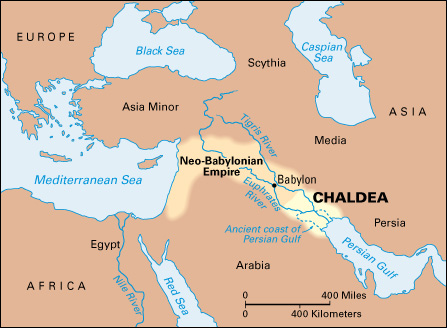Chaldeans, << kal DEE uhns, >> also spelled Chaldaeans, were a Semitic people who lived in lower Babylonia (now southeastern Iraq) by the early 800’s B.C. They settled in villages and small fortresses, often working as farmers. The Chaldeans spoke Semitic languages related to the Aramaic language. They were divided into several groups ruled by chieftains or kings.

As early as the mid-700’s B.C., Chaldean chieftains seized the throne of Babylon from time to time. The most important of these chieftains was Merodach-Baladan II, who held the throne from 721 to 710 B.C. and resisted Assyrian control of Babylonia. The Assyrians defeated Merodach-Baladan, but the Chaldeans continued to fight against them.
In 626 B.C., Nabopolassar, probably a Chaldean, founded a new dynasty (line of rulers) that lasted about 100 years. Aided by armies from Media and Scythia, he eliminated Assyrian power in the region by 609 B.C. He then took over most of the area of the former Assyrian Empire. Little is known about the government of the empire founded by Nabopolassar, but the reign of Nebuchadnezzar II, from 605 to 562 B.C., marked the height of Babylonian wealth and power.
Greeks and Romans later used the term Chaldean for almost anything Babylonian, particularly astronomical and astrological developments of the 600’s to the 400’s B.C. The Babylonians had long kept detailed astronomical records, and they could calculate the length of a year and predict eclipses of the moon and sun and the movements of planets and stars. “Chaldean” astrologers became famous for their system of supposedly reading the future in the movements of heavenly bodies.
See also Assyria ; Babylonia ; Nebuchadnezzar II .
